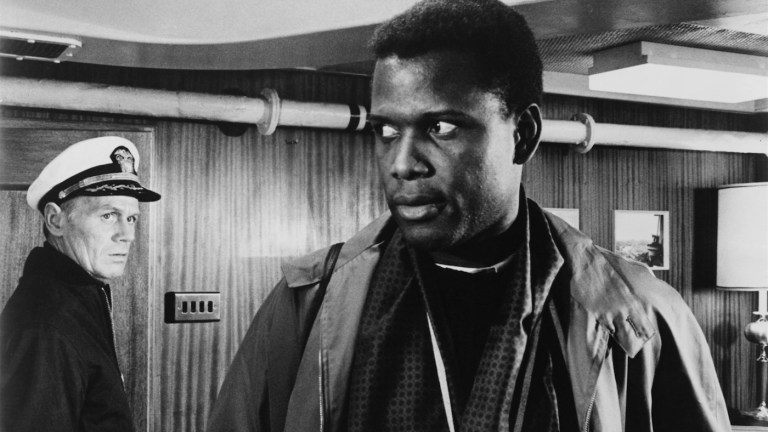Sidney Poitier’s Most Frightening Role Was as the Conscience of Nuclear War
The Bedford Incident is one of the most underrated nuclear nightmare movies, and one of Sidney Poitier’s least known classics.

Sidney Poitier, who died at age 94 last week, was a leading man in many ways: teaching the teacher in The Blackboard Jungle, learning from students in To Sir, With Love, and schooling the public on historic achievement with each part he took, from the slender threads to the defiant ones. One of Poitier’s greatest roles is as a costar, not only taking second billing to Richard Widmark in The Bedford Incident (1965), but to the premise of the movie itself: World War III in the Atomic Age. It may sound like a sci-fi setup, but the science was not fiction.
Poitier, who won the Best Actor Oscar in 1964 for Lilies of the Field, plays magazine reporter Ben Munceford in The Bedford Incident. The Cold War thriller isn’t as well-known as Stanley Kubrick’s Dr. Strangelove or: How I learned to Stop Worrying and Love the Bomb or Sidney Lumet’s Fail-Safe, but it is as chilling as any apocalyptic vision ever put on screen.
The Bedford Incident was directed by James B. Harris, who had been Kubrick’s producer until he turned Peter George’s 1958 novel Red Alert into the over-the-top farce of Dr. Strangelove. Harris was terrified of a nuclear standoff, and saw Mark Rascovich’s 1963 book The Bedford Incident as a powerful celluloid deterrent.
In the film, Widmark plays Captain Eric Finlander, the skipper of the USS Bedford, a destroyer equipped with tactical nuclear weapons, which is part of the NATO fleet. He is in pursuit of a Russian submarine, codenamed “Big Red,” off the coast of Greenland, which is armed with nuclear torpedoes. The Bedford traps Big Red among floating ice fields until the air runs out, forcing it to surface, and triggering a nuclear standoff.
Historical Close Calls with Nuclear War
Part of the reason The Bedford Incident so successfully plays into the terrors of global atomic warfare is because it is so meticulously crafted. It is not a fast-paced film. It is a realistic enactment told in a leisurely fashion so all the details can be put in their proper place, like the machinery of a submarine. This tinge of cinematic verité underscores what is so frightening about the movie. Complete global devastation can be triggered in the course of ordinary actions.
But the main reason The Bedford Incident is the stuff of recurring nuclear nightmares is because it is based on real incidents.
During the Cold War, U.S. Navy captains were trained to presume any Russian sub they encountered was equipped with nuclear torpedoes. A single Soviet nuclear ballistic submarine could carry over a dozen Intercontinental Ballistic Missiles armed with hydrogen bombs capable of destroying cities.
In August 1957, the USS Gudgeon was monitoring Russia’s Pacific naval base, Vladivostok, when it triggered an alert on Soviet radio channels. Eight destroyers set out in pursuit. After the sub’s captain, Lt. Cmdr. Norman B. ”Buzz” Bessac, failed to lose the ships by ordering the sub to “go quiet,” the Gudgeon dived 200 feet beneath the surface, well under periscope depth. Russian destroyers dropped depth charges. The Gudgeon shot decoys from its garbage tube, and submerged past the 700-feet maximum depth the ship was designed for to escape sonar.
The hold-down lasted over 30 hours before the sub requested backup from U.S. 7th Fleet headquarters in Japan. When the Gudgeon finally surfaced, its torpedo tubes were at the ready. After accepting the nautical intrusion as a navigational miscalculation, the Soviet ships allowed the Gudgeon to sail.
The second incident happened at the peak of the Cuban Missile Crisis. In October 1962, U.S. Navy destroyers in the Atlantic Ocean pursued the Soviet submarine B-59, which was armed with a T-5 nuclear torpedo. When the sub failed to surface, the destroyers dropped depth charges. The submarine captain was set to launch the T-5 but flotilla commander Vasili Arkhipov overruled the decision, and the standoff was handled diplomatically. The U.S. didn’t learn the submarine had nuclear capability until after the fall of the Soviet Union.
A Journalist in a Floating Tinderbox
Poitier plays a noted magazine photojournalist looking for the truth on a ship designed for secrecy. It is sadly ironic that it must be noted his part in The Bedford Incident was his first role where race is never mentioned and has no bearing on the story. The crew is honored to host Munceford as the first civilian on the U.S. Navy ship. He comes aboard with an unspoken reputation for bravery in military correspondence.
The crew treats him with high professional regard even though they know the profile he is writing on Finlander, a battle-hardened anti-communist hawk looking for a fight, may not fit with their inflated vision of their captain. Munceford is a political dove. He is also the eye of the public for an audience without top level clearance.
By the time Munceford is helicoptered to the Bedford, Finlander already made a name for himself by forcing a Russian submarine to the surface when it got too close to U.S. waters. With such a record, the reporter wants to know why this capable and charismatic captain was not made admiral. Munceford pointedly asks whether Finlander wasn’t promoted because he endorsed force during the Cuban Missile Crisis. The outspoken captain sees political diplomacy as a vulnerability, but strongly advises the reporter not to put words in his mouth.
“Everybody cooperates but nobody talks,” Munceford says as he gets his sea legs. He persuades security to let him see some tactical maneuvers, getting a seaman on disciplinary report. Finlander tells Munceford never to question how he handles his crew.
The cat-and-mouse game between the journalist and the captain is as tense as the one beneath the waves. They are allies yet political adversaries. Poitier’s reporter requested the dangerous on-ship assignment, and sets out to capture as many candid pictures as his trusty Nikon can snap. The camera is such an extension of Poitier’s physical portrayal of Munceford that it takes on its own characteristics. The camera is the silent witness to untold history.
As headquarters continues issuing “wait” orders, the reporter notes the captain’s increasingly reluctant adherence. Finlander’s frustration is understandable. From his point of view, the NATO fleet “are hunters stalking hunters, who track a foe who is also silently listening to us.”
The Bedford is equipped with “more computers than IBM” to track the undetermined craft. Donald Sutherland plays an onboard scientist who can even analyze whether the garbage left in a ship’s wake contains debris from Russian cuisine. Peppered red cabbage sauteed in butter and a weather balloon is all it takes to uncover a Soviet sub outside its jurisdiction.
The captain is under orders from the Fleet Commander to avoid contact, but if global war is declared, he would only have minutes to sink a submarine before it could launch ICBMs. It’s a lot to handle.
When War Hawks Go Nuclear
The Bedford Incident follows the tradition of The Enemy Below, and Star Trek’s “Balance of Terror.” The submarine standoff is a perfect analogy to psychologically submerged themes. The Bedford Incident is a dark reflection of The Caine Mutiny. Humphrey Bogart’s Capt. Philip Queeg is in pursuit of excellence and personally traumatized by substandard performance. His crew turns on him, labeling him a coward. The Bedford’s Finlander is a career Navy officer also breaking under the pressure of command, but tugging a willing and zealous crew along for the ride.
The Caine Mutiny was produced by Columbia Pictures with the full cooperation of the U.S. Navy, so the ultimate villain turns out to be Thomas Keefer (Fred MacMurray). He undermines Queeg, provokes the mutiny, and is exposed as a cowardly, selfish opportunist.
The Bedford Incident, distributed by Columbia Pictures but filmed at Shepperton Studios in the U.K., was made without Navy cooperation. It reflected the changing attitudes toward the military. It was co-produced by Widmark, who infused his Capt. Finlander with elements of Senator Barry Goldwater, the 1964 Republican presidential candidate voted most likely to start a nuclear war in the infamous “Daisy Girl” commercial. Commodore Wolfgang Schrepke (Eric Portman), a former Nazi U-boat commander onboard as a NATO attaché, says Finlander is “frightening.”
Finlander has earned recommendations, commendations, Naval Crosses, Stars, Hearts, and the utmost respect of the men under him. He commands nothing less than total obedience and expects nothing more than peak performance. These sailors would die for their commander. Some of the men turned down promising and lucrative civilian positions to serve specifically on his crew. They signed up for battle. They are there to see action.
When Munceford arrives on the Bedford, executive officer Commander Allison tells him the ship operates “under virtually wartime conditions” at all times. After incessant rounds of battle readiness, even the cool reporter gets worked up into a lather in the paranoid setting.
The film captures the dense atmosphere of close confinement on a ship without becoming claustrophobic, and the infinite dangers which surround it without signaling for help.
Chasing Moby Dick
Finlander is also an obsessed Capt. Ahab, and Big Red is his white whale. The Bedford Incident presents it as a contagion, affecting the crew. The only one to see this is medical officer Chester Potter (Martin Balsam), a Naval Reserve medic back on active duty after years of service and too many failed marriages. He fails to impose upon the captain the dangers of a crew always on high alert, in general quarters, primed for a battle they are ordered to avoid.
This diagnosis comes true when Seaman Merlin Queffle, the sonar man played by Wally Cox, breaks after logging too many hours interpreting blips and silences. In an earlier sequence, his character is excited to be helming the ship with his readings. He is caught up in the chase. He is the one subordinate Finlander openly enjoys a playful comradery with, but it is not enough to ease the psychological burden of Queffle’s brief stint at virtual command. When he cracks under pressure, the real commander cuts him no slack. He expects his sonar expert to be back at his post in no more than two hours, fully alert, and un-sedated. Trauma be damned.
This blurs the line between respect, duty, and fear. There are no malingerers on the Bedford; no mopery on the high seas; no gambling. But most importantly, no one under Finlander’s command would ever allow himself to be seen anywhere near sick bay.
Throughout the film, the captain attempts to break the enthusiastic Ensign Ralston (James MacArthur). Finlander admits “How hard it is to be a mean bastard,” in turning seamen into officers, and while the humor is topnotch for a military drama, his bemused tyrannical expectations have serious consequences.
Losing Your Cold War Conscience
Munceford is the only civilian aboard the Bedford, and Poitier maintains a casually irreverent and mischievously familiar air throughout his assignment. A bit of a wiseass, he is the justified voice of reason in the film and on the ship, but he cannot change the captain’s course.
Poitier’s roles were always more moral and humane than the characters surrounding them. He spoke to their conscience in ways no other actor could do. Poitier’s emotional arsenal was too formidable, varied, and grounded. Audiences could always trust him to do the right thing, and believe he will succeed in the last reel. When he fails in The Bedford Incident, he fails humanity.
Poitier and Widmark establish their opposing positions equitably and masterfully. They’d previously worked together on Poitier’s film debut, the 1950 drama No Way Out, and transmit a recognizable, if suspensefully ambiguous, chemistry. Their final conversation in the film comes after the dialogue has run out. They don’t need sentences. Their eyes communicate paragraphs. It is pure motion picture storytelling, and scary as hell.
In the pantheon of apocalyptic cinema, The Bedford Incident is highly regarded, but sadly underseen. It is more frightening than more epic doomsday films because it shows how realistically simple it could be to trigger armageddon. Poitier brings the universal appeal of unreasoning terror by playing the ineffective everyman. If he can’t stop the madness, none of us can.


